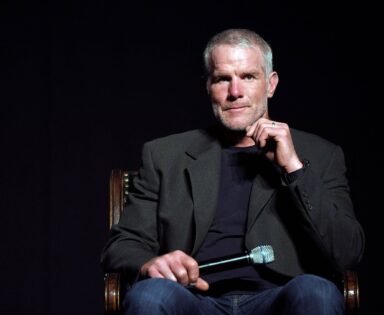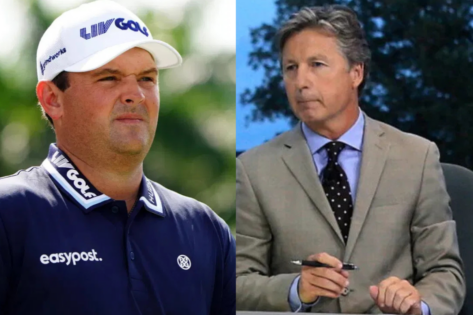Remember Brett Favre on that frozen Lambeau turf, December 22nd, 2003? Twenty-four hours after his father’s sudden death, tears mingling with icy breath, he unleashed a cathartic masterpiece: 399 yards, 4 TDs against the Raiders. It was the ultimate testament to toughness, a gunslinger playing through unimaginable pain. The unbreakable Iron Man, 297 consecutive starts deep into a Hall of Fame career (71,838 yards, 508 TDs, 3 straight MVPs) – etched his name in NFL lore. It’s the very definition of football spunk. But years later, after a heroic history, Favre is sharing a strange statement against football, which might question the identity of the sport. Wait….what?
“The human head is not designed to play football.” Packers‘ legend Favre dropped this seismic statement like a Hail Mary into the national conversation—a stark reversal from the man who embodied the sport’s brutal beauty. The revelation came from a conversation with Dr. Bennet Omalu, the pioneering neuropathologist whose CTE research rocked the NFL (famously portrayed in Concussion).
Favre, grappling with his own recent Parkinson’s diagnosis—which he attributes to enduring “hundreds, probably thousands” of concussions during his 20-year career—sought answers. He recalled the critical question he asked Dr. Omalu, which many parents ponder: “Dr. Omalu, when is a good time to play tackle football? What age?” The answer was a sledgehammer to the sport’s foundation: “And he said, ‘Never.’”
A post shared by TheHeadRushPodcastwithPaulFraseand CoreyBerry (@theheadrushpodcast)
Dr. Omalu’s reasoning cuts to the core of the issue: “He said, yeah, a 25-year-old’s head is probably fully developed, when an 8-year-old’s is certainly not.” Think about that contrast. A 25-year-old brain, myelination largely complete, prefrontal cortex wired for better impulse control and resilience, still not truly equipped for the repeated, jarring impacts inherent in tackle football. An 8-year-old’s brain?
It’s like comparing a seasoned oak to a sapling in a hurricane. The developing skull, the still-pruning neural pathways, the high water content—it’s biomechanically fragile. Boston University’s chilling research backs this up, finding CTE in 91.7% of 376 studied former NFL brains, and showing kids who start tackling before 12 face significantly earlier cognitive and emotional decline. Cases like 18-year-old Wyatt Bramwell, diagnosed with Stage 2 CTE after a decade of youth football ending in tragedy, are the heartbreaking proof.
“So to answer your question, Brett, older is better when the head is developed,” Favre recounted Omalu saying, before delivering the inescapable verdict again: “He said, but the human head is not designed to play football.”
This isn’t just stats on a page; it’s the lived reality of legends. Junior Seau. Mike Webster. Dave Duerson. Andre Waters. Their post-mortem CTE diagnoses scream the silent cost of those collisions Favre weathered week after week—the price of his record-setting durability. It’s the fear Favre now voices about forgetting moments from his own daughter’s childhood. It transforms the man who once scrambled fearlessly into a reluctant prophet, urging parents to delay tackle football until at least age 14.
So, in short, parents hurl their children into playing tackle football at a very early age. But the result? It might increase the chances of CTE. As Favre himself might reflect on that iconic, grief-fueled MNF performance, the cheers fade, leaving only the echoing truth: the human head was never meant for this game. The chilling truth in Brett Favre’s warning isn’t just philosophical—it’s etched in broken neurons, autopsied brains, and shattered lives. Let’s dissect why his message, forged in personal agony and scientific rigor, demands attention.
The Science of Fragile Skulls
Dr. Omalu’s declaration—“the human head is not designed to play football”—isn’t hyperbole. It’s biomechanics:
Child Brains vs. Adult Brains:
At age 8, the brain is 90% developed but critically unfinished. Grey matter peaks at 12, followed by synaptic pruning. Myelination (nerve insulation) remains incomplete until the mid-20s.
Impact: A child’s brain has higher water content, weaker blood-flow regulation, and less structural integrity. Hits disrupt neural wiring during development, risking permanent cognitive/emotional pathways.
Data: Boston University found players who started tackle football before 12 developed CTE symptoms 13 years earlier than late starters. Each year, under 12 added ~2.4 years to symptom onset.
Even Adults Aren’t Safe:
A 25-year-old’s brain, while “fully developed,” still suffers. Helmets protect skulls, not brains. The organ sloshes inside the cranium on impact, stretching, shearing, and accumulating tau proteins (CTE’s hallmark).
Favre’s “hundreds, maybe thousands” of concussions mirror tragedies across football:
NFL Carnage: 345 of 376 former NFL brains studied at BU had CTE (91.7%). Cases like:
Junior Seau (43): Suicide. Severe CTE.
Aaron Hernandez (27): Stage 3 CTE—violent behavior, suicide in prison.
Andre Waters (44): Brain resembled an 85-year-old Alzheimer’s patient.
Youth Football’s Hidden Graves:
Wyatt Bramwell (18): Stage 2 CTE after 10 years of tackle football. His final journal entry: “I took a lot of hits… I took a lot of concussions.”
Patrick Risha (32): Dartmouth running back. CTE confirmed post-suicide. His mother founded StopCTE.org, pleading: “No tackle before 14.”
Favre’s Parkinson’s diagnosis (2024) isn’t anecdotal—it’s neuroscience: Concussion Multiplier: One concussion increases Parkinson’s risk by 57% and dementia by 72%. Favre’s estimated thousands of sub-concussive “dings“ created a perfect storm. His Own Words: “I don’t remember my daughter playing soccer, playing youth soccer, one summer. I don’t remember that. … This was pretty shocking to me that I couldn’t remember my daughter playing youth soccer, just one summer. … I think she played eight. So that’s a little bit scary to me. For the first time in 44 years, that kind of put a little fear in me.”
The gunslinger who defined toughness for a generation now warns that very toughness comes at a neurological cost; the human body simply isn’t built to pay. His message, echoing from Dr. Omalu through the lens of his own Parkinson’s battle, isn’t just a hot take—it’s a fundamental challenge to the sport’s future, delivered by the unlikeliest of messengers: the NFL’s ultimate Iron Man, confronting the fragility he once seemed to defy.
Favre’s advocacy aligns with urgent policy shifts: States Acting: California, New York, Illinois pushing bills to ban tackle football before age 12, NFL’s Quiet Concession: League funds flag football programs for ages 6–12, citing “safety and accessibility.” Dr. Omalu’s Ultimatum (summary): ‘If your child plays tackle football before 14, you’re introducing them to a high-risk activity. Period.‘
When a 25-year-old’s “mature” brain still degrades from hits, and an 8-year-old’s developing mind is biomechanically defenseless, the sport’s existential crisis is undeniable. Favre isn’t killing football; he’s pleading to save children from the darkness he now faces. As Patrick Risha’s mother warns: “CTE is 100 percent preventable… If we don’t do anything, we’re all complicit in the problem.” The unbreakable man’s breaking point is the warning we can’t afford to ignore.
The post Brett Favre Issues Strong Message to America Against Tackle Football After Major Revelation appeared first on EssentiallySports.



